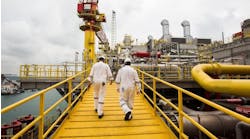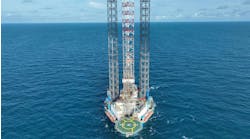Expanding contractor brings novel approach to subsea designs
The Orkhanger base (foreground) is now an important resource for Reinertsen Vigor.With the acquisition of an offshore fabrication base, Reinertsen Vigor has positioned itself to serve the boom in development activities off mid Norway.
Reinertsen Vigor is the result of the take-over by Trondheim-based Reinertsen Engineering of the Vigor base just along the coast at Orkhanger. The move was prompted by the need to maintain a competitive edge in the era of turnkey contracting which has coincided with the Norsok campaign for greater cost and time-efficiency.
Adding fabrication to Reinertsen's traditional engineering activity - it has a strong track-record in pipeline engineering - has enabled it to offer solutions which would not be available to a single-discipline contractor, according to Geir Suul, managing director of the merged company.
"You have to find ways of saving the client money if you're going to get a proper margin these days," he says. "By integrating engineering and fabrication, we are managing to find those ways.
"We want to look at things differently from everyone else. Our aim is to be 30% cheaper than the competition through cost-effective engineering solutions."
By way of example, he mentions the subsea protection structures for the Gullfaks Satellites project which the company is supplying under an EPC contract to Kongsberg Offshore. Originally designed with four double legs, the structures were redesigned with four single legs made out of spiral welded pipe.
With assistance from the Rautaruukki steel mill in Finland, where the welding process for the legs was qualified, Reinertsen managed to halve the steel cost of the structures, Suul says.
The company has now proposed the use of spiral welded pipe for line-pipe fabrication to Statoil. "Our method is simpler and more efficient than traditional means," says Suul. "By varying the angle of roll during fabrication, the diameter of the pipe can be changed."
The fillet welds specified for this method are also simpler and more cost-effective than the full welds which an engineer without the benefit of fabrication input would be likely to specify, he says.
In fact the merger of the two companies appears to have sparked a radical rethinking of some basic offshore assumptions. One example is a research project into the use of wood in place of the steel used for the tubulars of subsea structures, which has now received a NKr 300,000 grant from the Norwegian Research Council.
"Twenty five per cent of the cost of a subsea structure goes on corrosion protection," Suul explains. "The use of wood is cheaper, and it would save a lot on coating, sandblasting and anodes." Another initiative, which has reached the testing stage, is the use of car seat belts as protection against dropped objects.
The take-over has opened up other new avenues for Reinertsen Vigor. One of these is the maintenance and modifications market, in which two successes have already been scored - 10-year contracts on Statoil's Heidrun platform, for which the lead contractor is Transocean, and at the same operator's Tjeldbergodden methanol plant, where Reinertsen Vigor is the main contractor, with responsibility for engineering, prefabrication and installation.
"This work provides valuable experience for us to bring back into engineering," says Suul, who welcomes the risk-reward type of contract strategy currently favored by oil companies.
The company is also keen to build process modules, another area in which it sees its engineering/fabrication capability opening the way to more cost-effective solutions. It has prequalified to tender for the Aasgard B systems modules which Kvaerner is shortly to subcontract out.
Reinertsen's engineering experience in this field includes the process modules for the Troll Oil terminal at Mongstad and for the Tjeldbergodden methanol plant. In pre-merger days the process modules for Elf's Frigg Field were fabricated at the Vigor base. A modest upgrading of the Orkhanger facilities would be required to tackle such work, involving mainly an increased crane capacity, Suul says.
The 60,000 sq meter base is situated alongside Coflexip Stena Offshore's Orkhanger site, a juxtaposition which has brought the two companies into a natural working relationship. CSO's reeled pipelines are welded at the Vigor base, which also fabricated the suction anchors for Esso's Balder production ship as a subcontract to CSO.
Meanwhile the company continues to be busy in the area of pipeline engineering. One current project is the detailed engineering for the 119-km, 36-in export pipeline for Norsk Hydro's Oseberg Gas development. As a subcontractor to J P Kenny, the company also performed part of the engineering for the complex of new pipelines at Phillips' Ekofisk Field.
Its portfolio also includes projects off mid Norway, including pipeline studies for Saga's Lavrans and Kristin Fields, not to mention the same operator's Snorre North development in the North Sea. Studies have also been performed for the condensate export line proposed by Statoil for the Aasgard area.
Copyright 1997 Oil & Gas Journal. All Rights Reserved.


